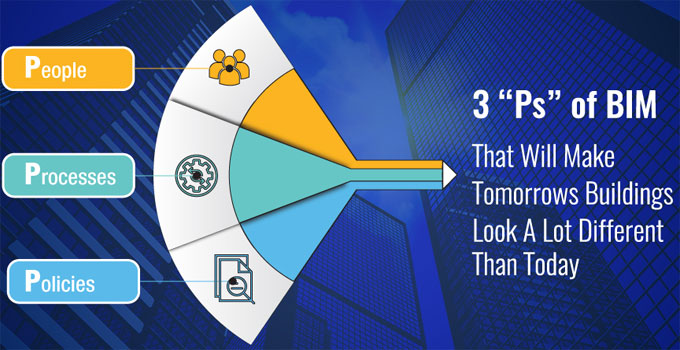Future construction project should rely on 3 P’s of BIM (People, Process & Policies)

To reap the complete benefits of BIM for next generation of construction, the emphasis should be given on the 3 ‘Ps’ of BIM i.e. people, process and policies.
People is the first ‘P’ of BIM: To implement BIM in a positive manner, the organization should need the entire team to realize its significance and accept it’s adaptability. The people are mostly responsible to bring in the advancement and so it should be given first priority against the processes and policies.
It is very crucial to develop sound relationships with professionals, in-house teams or a design support solutions provider. It is considered as one of the most vital factors while commencing technological conversion.
Process is the second ‘P’ of BIM: Sometimes, it is found that even skilled AEC professionals find it difficult to execute BIM though they are fully conscious concerning the benefits of the BIM. They mostly prefer to adopt the shortest and simplest method by employing the new technology with old processes. They give priority to use the obsolete processes because they are accustomed and comfortable with them.
As for instance, it is found that professionals or AEC firms using a building program in Microsoft Excel on one monitor, and although, they require Autodesk AutoCAD or Revit. They are engaged in generating and regenerating the data while they can employ Excel-to-Revit tools and produce spaces from Excel in Revit automatically. Lots of processes produce a lot of data waste over the lifespan of construction projects.
The third ‘P’ of BIM is policies: While going to adopt BIM-friendly processes, company policies are considered as the major barrier to overcome.
BIM becomes effective when all the people, who are associated with the construction project, can distribute information without restrictions as well as collaborate. Contracts generally prohibit information distribution by adhering to the clause of confidentiality, liability and litigation concerns. So, it is vital to understand that design solutions are essential to the protect companies as well as inspire them to collaborate.
Companies can also safeguard themselves with the use of filters to the information they distribute; as for instance, building plans should be marked with green, yellow, or red, to specify whether the information is final, provisional, or incomplete. By making collaboration with stakeholders, all parties can mutually settle definitions, processes, policies, and parameters before the commencement of any project. This initiative can minimize risk and at the same time reorganize the workflows that BIM depends upon.
Article Source : www.pbctoday.co.uk

